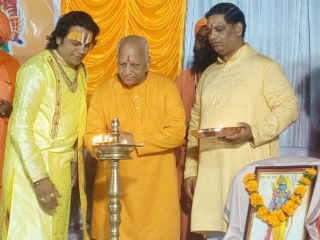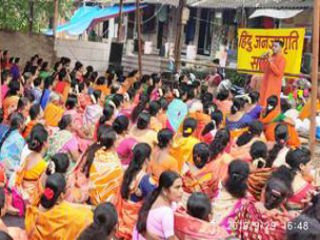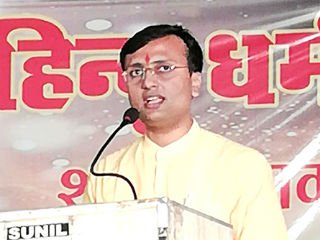This question is routinely asked at Hindu gatherings. We are not here to make any judgement. But this widespread Hindu angst needs to be addressed and answered.
Take for instance, the efforts of a section of the visual and print media in the wake of the Malegaon tragedy. They exercised all the tricks in the trade to establish a Hindu terror link with the blasts in the mosque premises. Till date, there is no known Hindu terrorist organisation anywhere in the world. To paint Bajrang Dal or Shiv Sena terrorist is to make a falcon out of a pigeon. But to neutralise the impact of the Mumbai serial blasts, they invented a Hindu terrorist backlash. The story could not be sustained for want of evidence.
Similarly within minutes of the tragic death of Prof. H.S. Sabharwal in the students’ clash in a college in Ujjain, one English TV channel was breaking the news about the goondaism of the ‘Sangh Parivar goons’. Choicest epithets are hurled at the Hindu activists, as if it is the only way to report an incident involving the Sangh affiliates. The print media is more circumspect on such occasions.
Consider this against the reverence with which the media treat the representatives of Muslim terrorist outfits. We have the spectacle of Yasin Malik, SAR Geelani and the Hurriyat honchos talking about human rights and fair trial. They dominate the visual media. The vicious antipathy that most of the media celebrities exhibit for the Hindu leadership is inversely proportionate to the extreme politeness they exude for the merchants of terror and their voluntary counsels in the human rights lobby. Is it only because of the media’s implicit love for secularism or because of the compulsions of market considerations? Admitted. It is not profitable to argue the Hindu cause. For there is no monolithic establishment to respond.
The idea of this Deepavali Special is to provoke a debate. It is perhaps preposterous, as Saeed Naqvi says in his write up to suggest that Indian media is anti-Hindu. Even the VHP leader Pravin Togadia disagrees with our poser, he says in a country with an 85 per cent Hindu population media cannot afford to be anti-Hindu, it is pro-Hindu.
We have tried to make this debate as wide ranging and representative as possible. Malini Parthasarathy of The Hindu is very candid when she says, the media is neither pro nor anti-Hindu but it definitely has to be against the Sangh Parivar.
This is the crux of this debate. The Sangh has in a way created an atmosphere in the country to think Hindu. It was on the Deepavali eve two years ago, that His Holiness Shankaracharya Shri Jayendra Saraswati was arrested by the Tamil Nadu police in a murder charge. The protest against the arrest was not massive. For almost a fortnight the media feasted on a mountain of salacious canard to defame the 2000 year old Kanchi mutt and in the process denigrate the Hindu faith. The political arithmetic, we were told by the media was that the then chief minister Jayalalithaa wanted to consolidate her position, by discarding her pro-Hindu label. According to them she lost the Lok Sabha polls because of the minority revolt. She took a series of steps, cheered by the media, to reclaim her pro-minority-Dravidian image. For that if the faith of millions of Hindus was hurt so be it. Political survival is more important.
A few months ago in the assembly election she lost despite all her pronouncedly anti-Hindu actions. But the media did not bother to analyse if there was an element of Hindu retaliation that also worked against Jayalalithaa.
Uttar Pradesh is considered the most effective laboratory of Muslim politics in the country. The only time the BJP won a convincing victory in the state, going it alone, was in 1990. On the crest of Ramjanmabhoomi campaign wave. In fact, the BJP attracted the cream of the Indian society into its fold in the wake of the Ramjanmabhoomi agitation, because of its support for the movement.
The Ramjanmabhoomi movement for the first time made Indians think Hindu. Rather it exposed the pseudo-secular facade of the Nehruvian politics. Which has once again become the guiding principle of the UPA conglomerate. The media moguls rushed to analyse the 2003 BJP victories in Madhya Pradesh, Rajasthan and Chhattisgarh as a mandate for development plank Bipasa, they romantically described not for Hindutva. True. It was a vote for development. Then why this concerted tirade against the BJP? Naqvi is right when he says it is market that drives the media. Hindu is on the receiving end because he has no money. He has no political clout. No government support. No petro dollar. And no evangelical aid. In the clash of civilisations Hindu is a lone fighter. For his very survival.
If the secular media is committed to the creation of the Indian identity as enshrined in the Constitution, then it should have no quarrel with the Sangh. For, it is the only organisation that works to make every citizen of this country feel Indian. Others only keep reminding us of caste, subcaste, regional and religious fractions. Yes, RSS has also made the Hindu aware of his political worth. That, in a democracy number is important. And that in every region where Hindu is in a minority, there is a problem of separatism. Is that reason enough to attack the Sangh? Because there is no powerful Hindu lobby in Indian polity, the media gives a left handed treatment to the Hindu sensitivities.
For instance, the coverage of Hindu festivals is an occasion to focus on the lewd, vulgar commercialisation which is only a part. But such liberties are not taken with a Christmas or Ramzan festivity. It is the pious, religious side that is highlighted. Our purpose here is to give expression to this widely held belief that the media has become insensitive to the feelings of the majority community in the country.
http://www.organiser.org/dynamic/modules.php?name=Content&pa=showpage&pid=153&page=2




